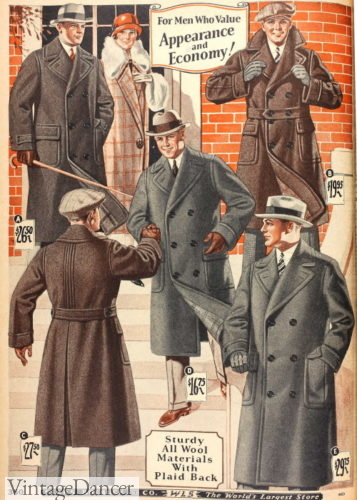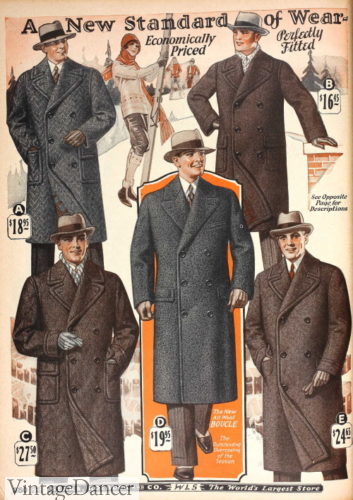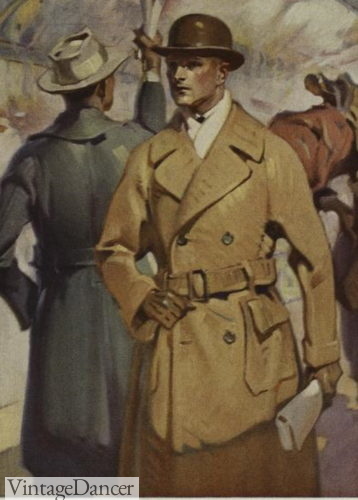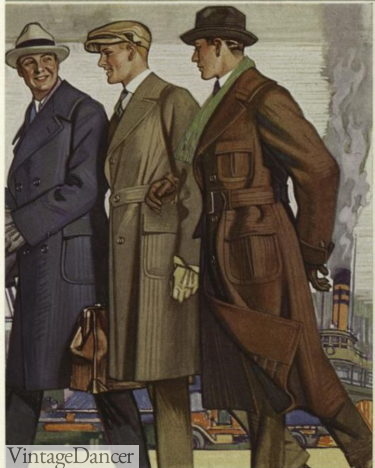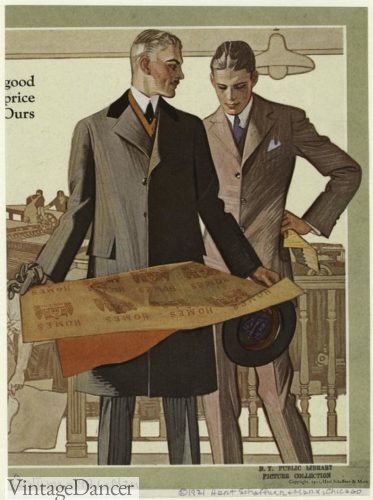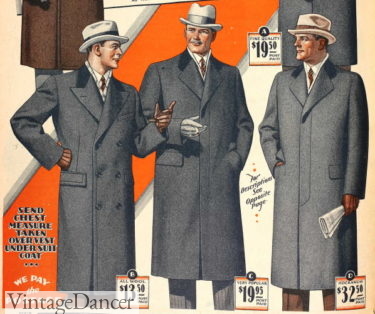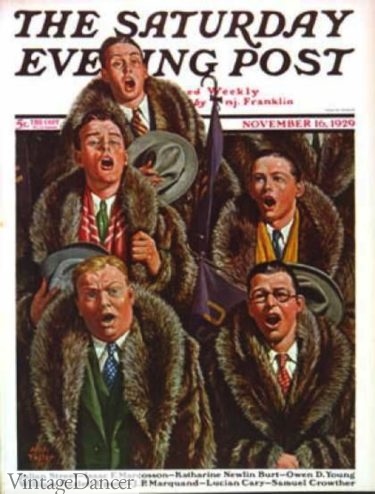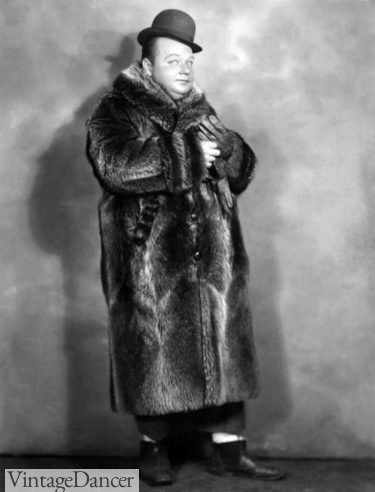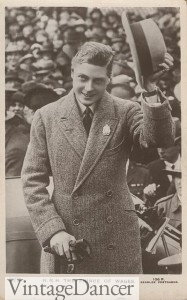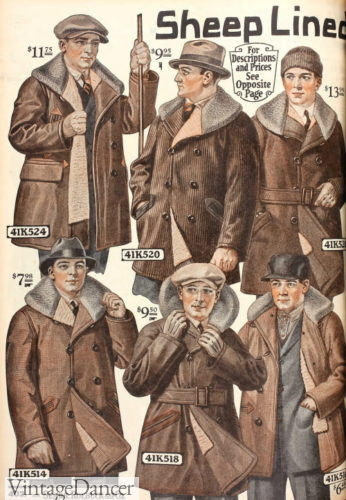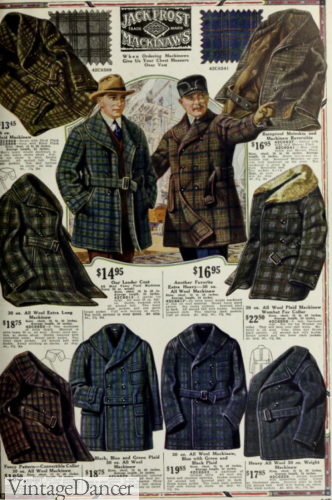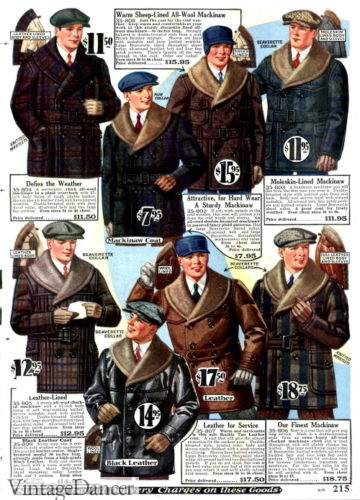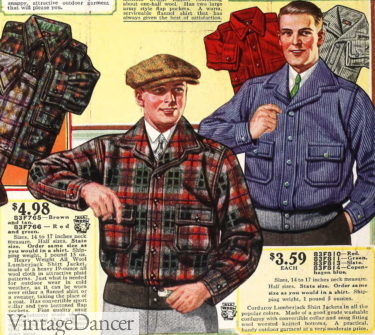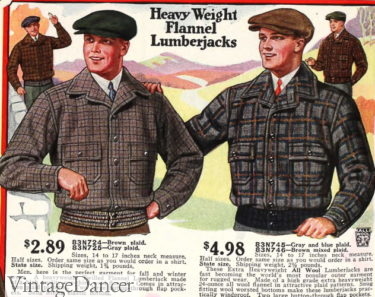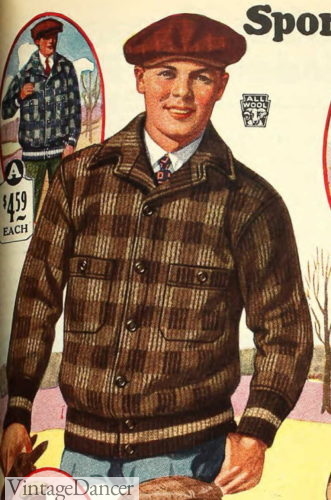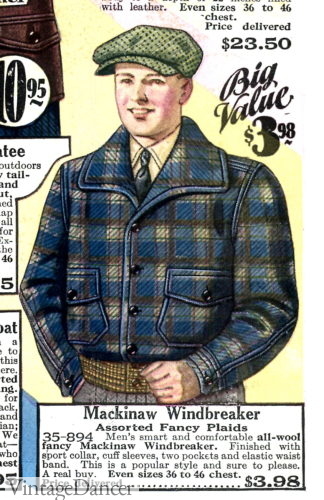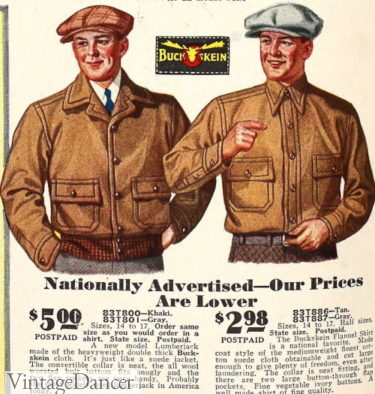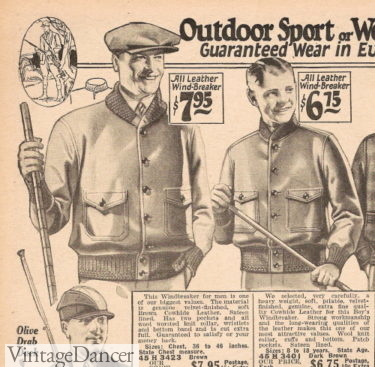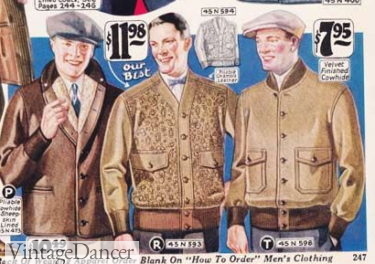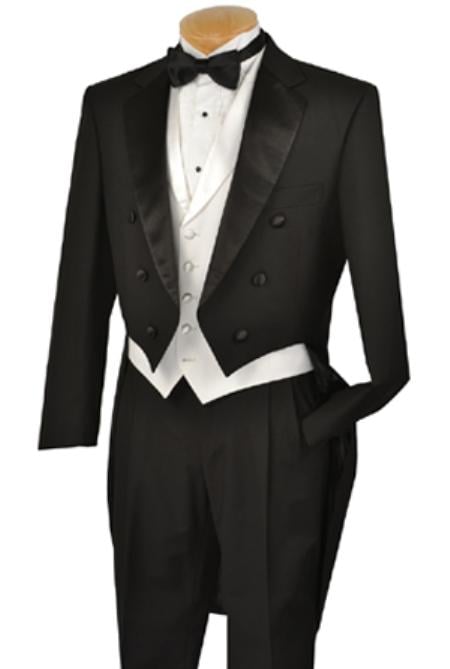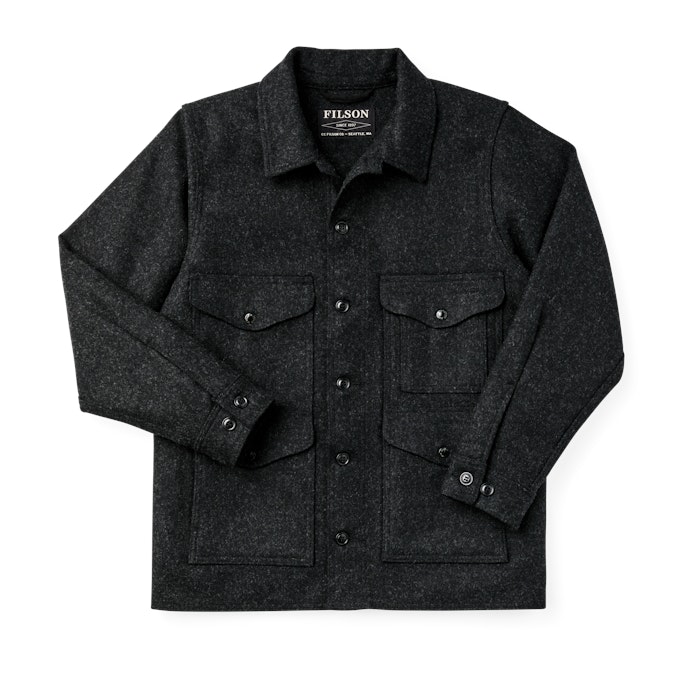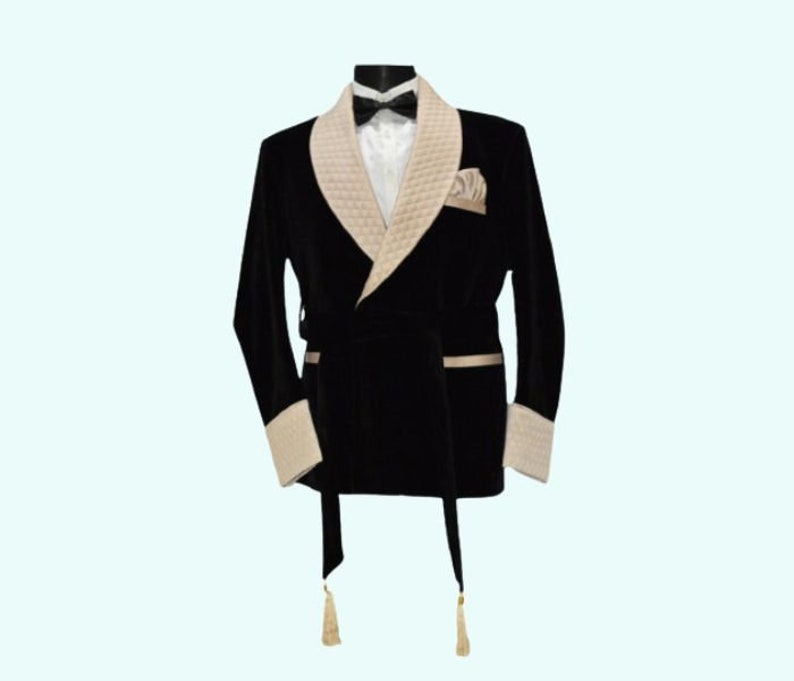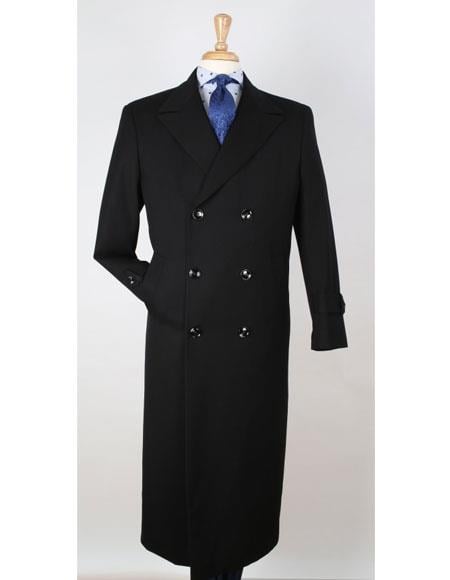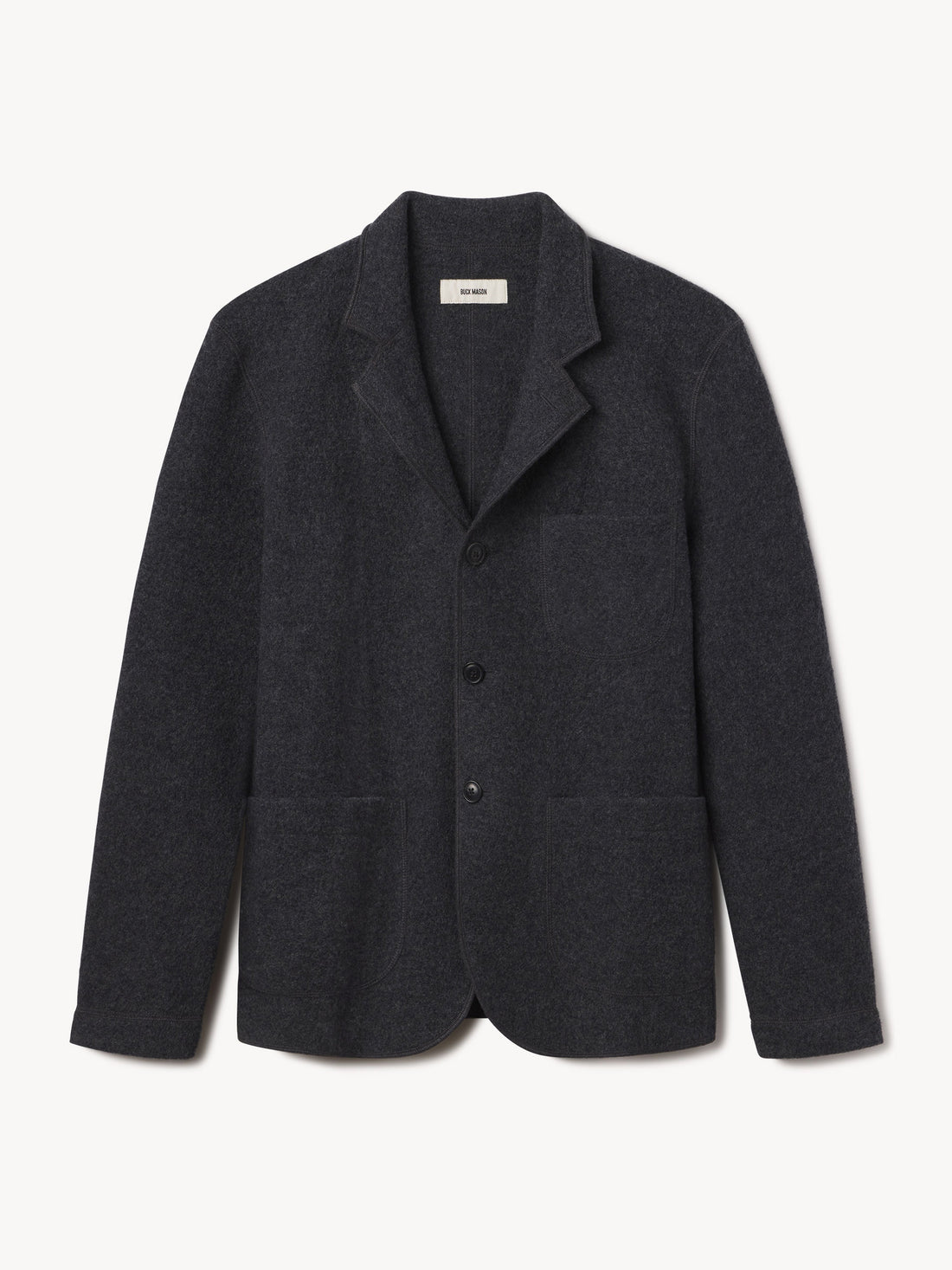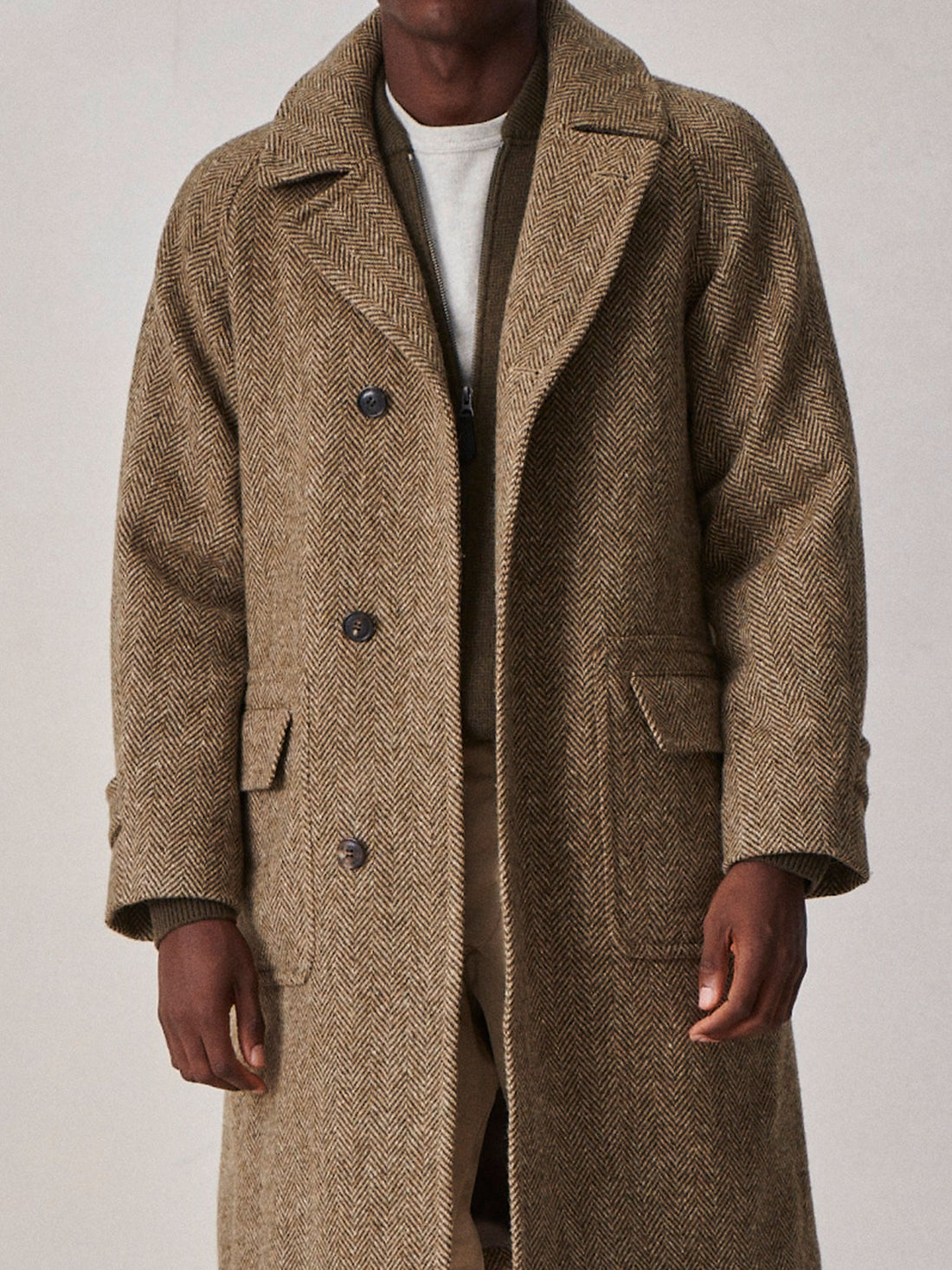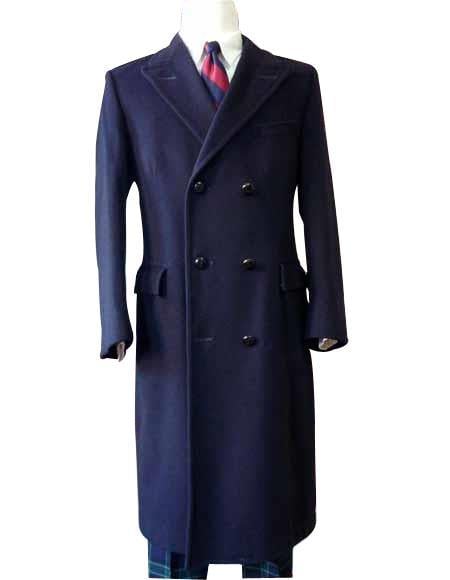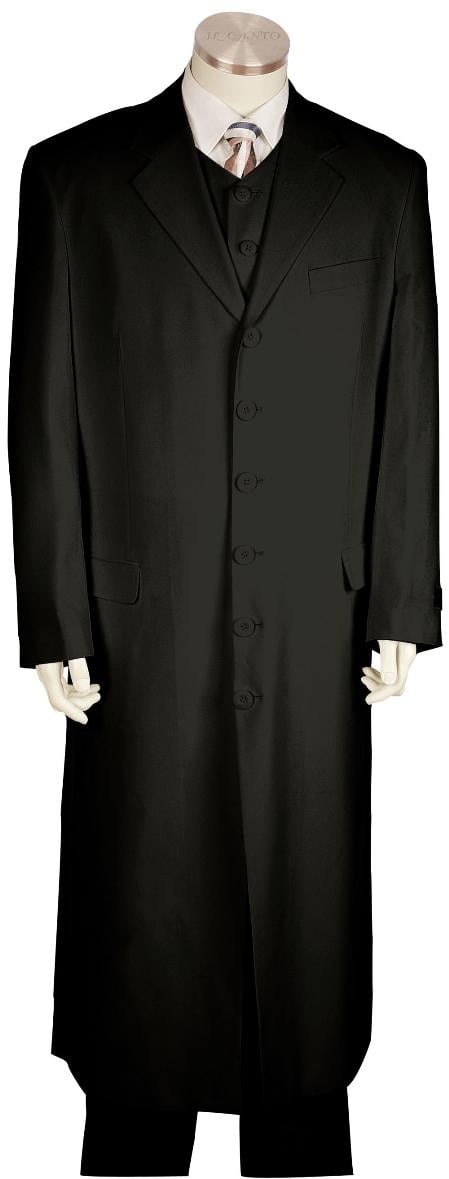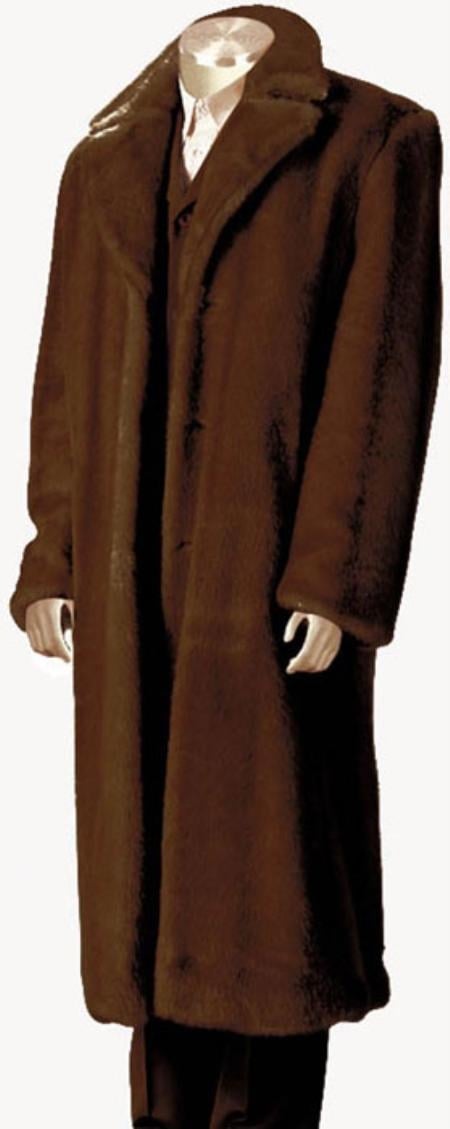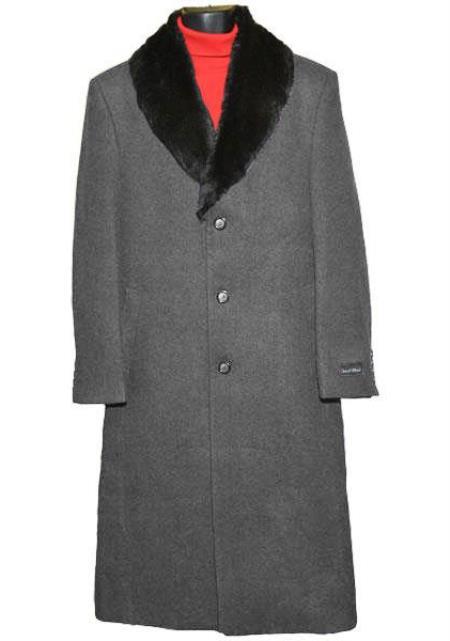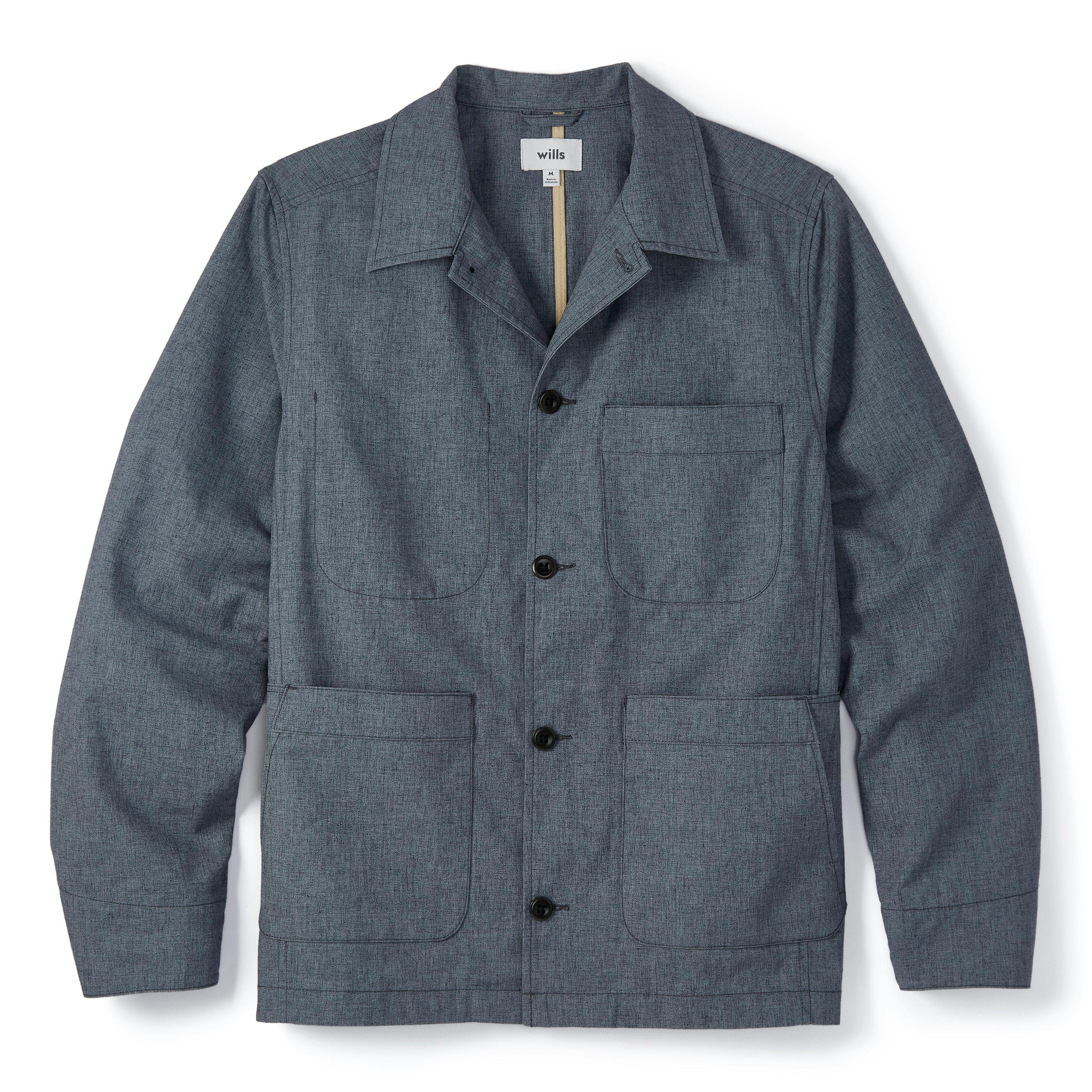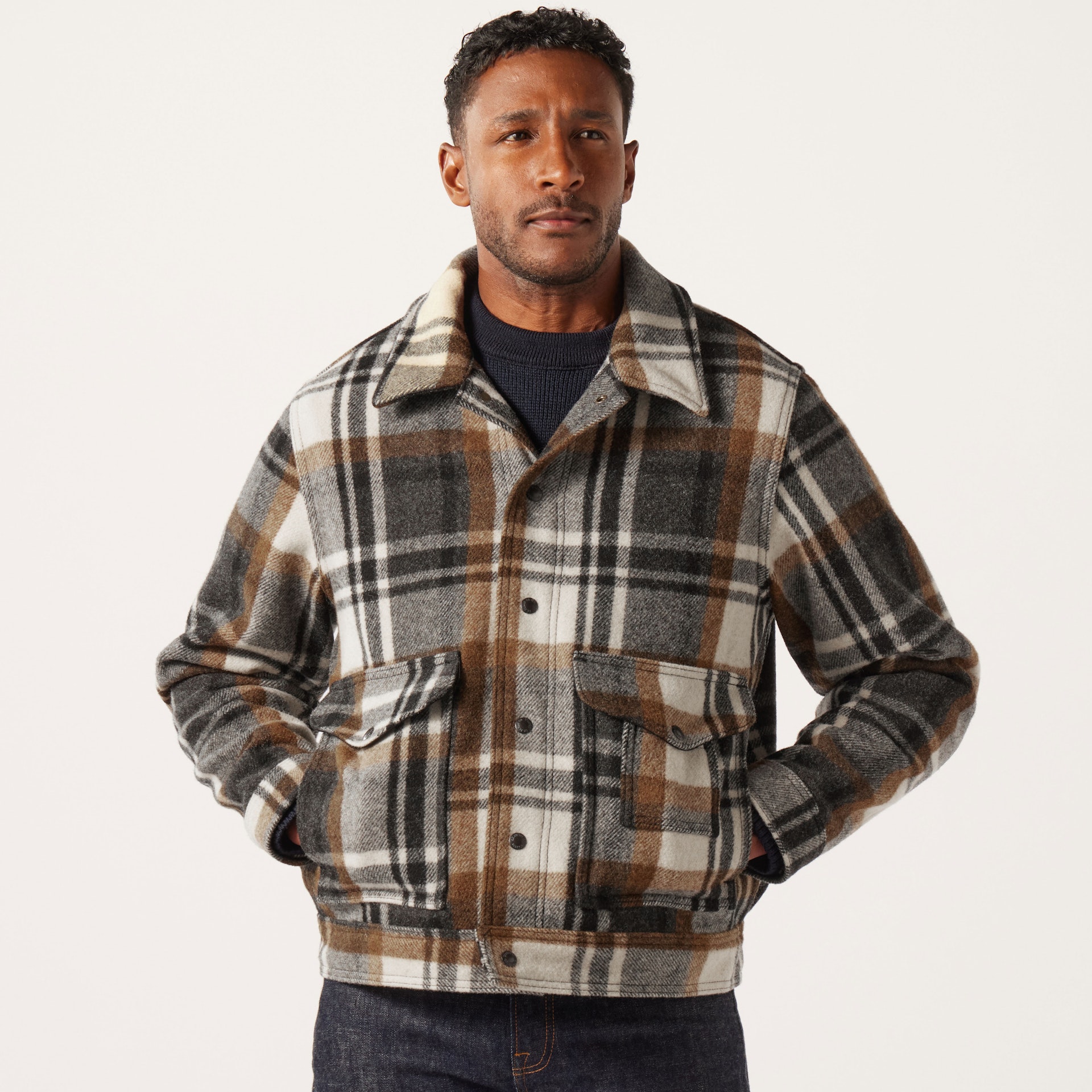Even though World War I had ended, men’s and women’s 1920s overcoats and jackets continued to be styled after British military coats. Long knee length wool 1920s men’s coats with wide lapels, broad shoulders and a tightly fitted waist emphasized the thin and muscular physique. Men’s coats hung down to below the knee. They came in rich dark colors such as brown, grey and navy blue, a favorite color of the Peaky Blinders men.
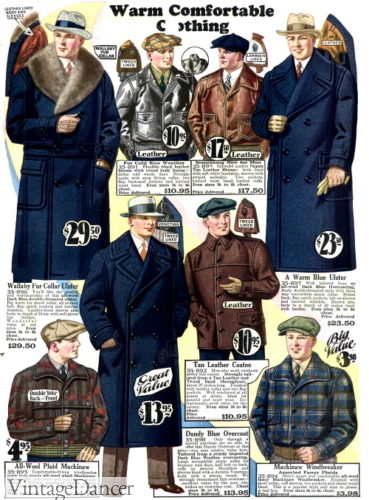
1928 men’s coats and jackets
Prior to the war, men were not encouraged to exercise or build their natural bodies. The ultra thin and narrow “jazz” look was the ideal Edwardian fashion. Military training officers had a fair amount of physical training to do to get these waifish men into more suitable shape for the rigors of war. It was only natural that men returning from war could no longer fit into their pre-war clothing, or appreciate their snug suits. Military clothing was more comfortable and more flattering on their new bodies.
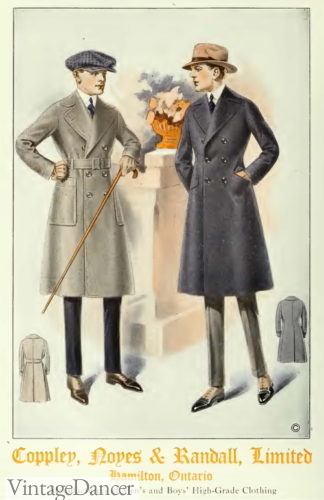
1920 double breasted coats with a high waistline
As 1920s suits grew more fitted in the torso, so did the overcoat in the early twenties. Then, as suits grew a bit wider and looser, the coats followed as well. What stayed the same was losing the bulky fur lining that was a part of most men’s coats in the late teens. Now, a simple silk lining inside a lighter wool or tweed coat was all that was needed. Being fitted up top but roomy around the waist and hips made them easy to move in despite the mid-shin length.

Young Men’s 1920 coat varieties
The nipped in waist made by a tight belt lost favor over the straight hanging long coat for most of the ’20s. Single- or double-breasted varieties in popular black, grey, dark brown, and herringbone in black and white or brown and white endured the decade. Oddly enough, men’s overcoats were not brash and colorful as most other clothing was. Younger wealthier men preferred lighter shades and blends of blue-grey or tan-brown but that was as far as colors go.
In 1923, the British trend for dark blue coats came to America. It was touted as the color that flattered all shapes, sizes and ages. It was the new “black.” Besides coats, dark formal dinner jackets came in dark blue along with men’s business suits and casual pants.
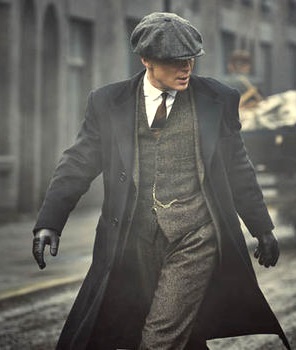
Peaky Blinders coat, a navy blue chesterfield
1920s Long Overcoats
Ulster Coat
Often loose fitting and made of rough, homespun, textured moleskin, Melton wool, Chinchilla (not the animal) or gaberdine, the Ulster coat was a long, double-breasted winter overcoat with very large notch lapels that folded over each other so the coat could be buttoned up all the way. True Ulsters have wide cuffs at the wrist, two large front patch pockets with flaps, a half belt on the back and contrast stitching. The look comes from country gentlemen’s wear in the province of Ulster, Ireland.
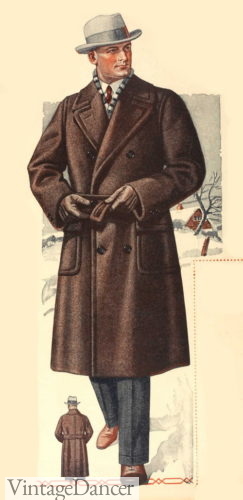
1925 men’s ulster coat
Common Ulster colors were black, grey, deep brown, and olive green. Blue was exceedingly popular in the middle to later half of the decade. Some came in plaid or check patterns but plain fabrics were preferred. Lining were heavy blanket cloth or sheering or faux fur plush. Sleeves were lined in silk or satin.
- 1925 ulster coats
- 1928
Some men’s 1920s coats were a cross between Ulster and Trench coat with a button over belt. The single breasted coat was rare until the end of the decade.
- 1925 ulster coats
- 1928
Despite that women’s coats frequently had a large collar collar, men’s coats typically did not. There were some in the early years and again going into the 1930s. Fur collars could be real or faux wombat, seal, beaver and sheepskin. They were often fully lined in piled fur/plush.
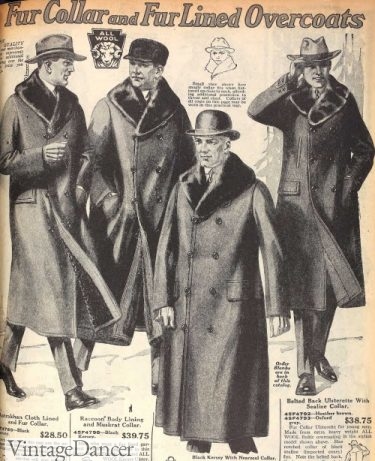
1921 fur collar and fur lined overcoats
Raincoats
For heavier rain, a full rubber, oil cloth or rubberized cloth slicker was in order. These wide and box coats had a flip up corduroy collars, snap or metal frog buttons, and large flap pockets. They were very brightly colored in yellow, olive green, or classic black.
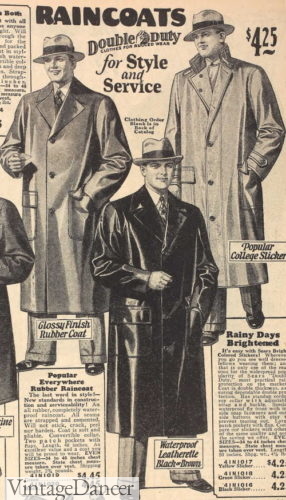
1928 men’s raincoats
Trench Coats
Many overcoats resembled trench coats with a wide center belt, two large hip pockets, and a just-below-the-knee length. They were made to repel spring rain in a lighter fabric such as Gabardine, sometimes treated in a “Cravenette” rubberizing process. Usually, they were tan in color. This went on to become the everyday men’s coat of the 1930s.
- 1921 trench coat
- 1921 Trench coat colors
The Chesterfield coat was another style that had lesser popularity. Considered an “old” style, it was usually black with a velvet collar. Single- or double-breasted it came back in fashion in the late ’20s when men’s coats were more simple and refined. It looks especially classic with a Derby hat while younger men pair it with a homburg.
- 1921 Men’s Chesterfield coat
- 1929 chesterfield coats return
1920s Men’s Raccoon Coat
In general, all fur coats were rare for men to wear after the war years. Only in the most extreme winter conditions were they seen among those that could afford it, even fake furs. The exception was the racoon coat.
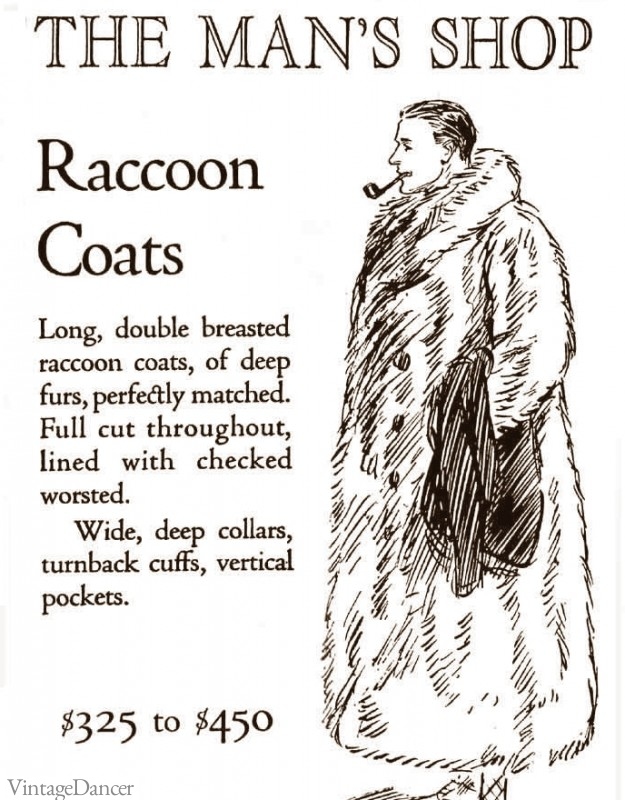
Raccoon Coat Ad with Hefty Price Tag- About $5K in Today’s USA Currency
The famous raccoon coat, became a trend and symbol of swanky young college men with sex appeal just like their movie star idol Rudolph Valentino. All young men and Hollywood types, regardless of age, were quick to buy and wear a raccoon coat, even if it was only worn two or three times a year to football games or out cruising in open top flivvers with flapper girls.
- 1929 Life magazine cover featuring Collage Kids in Racoon coats.
- All fur oat (racoon tail on the pockets)
“College men, knowledge men
Do a dance called raccoon
It’s the craze, nowadays,
And it will get you soon.
Buy a coat and try it,
I’ll bet you’ll be a riot,
It’s a wow, learn to do it right now!”
(George Olsen and His Music. Listen here.)

A group on young men wearing Racoon coats
Hats with Coats
The type of coat a man would buy had a lot to do with the hat he wore. Conservative men were enjoying the new fad for the rolled brim Derby hat (AKA bowler hat) while wearing single-breasted, wide peak lapel coats. College men preferred the creased felt hat similar to a Homburg. Trilbies or fedoras were worn with a double-breasted, slightly shorter, trench coat style.
Having a unified look identified men as gentlemen. The wrong hat with the wrong coat, gloves, or shoes was a fashion disaster!
1920s Men’s Short Coats
For working men, sporting men, and leisure wear, a long overcoat was too cumbersome to wear. Shorter, hip level Coatee coats (about 36 inches in length), looked like Ulsters with large shawl collars of fur or shearling wool. They were fully lined in shearling or Melton wool cloth. Most had flap pockets, double breasted buttons, and a slide or button belt. In the later years an angled slit chest pocket was added to the chest.
Thick and heavy they were incredibly warm. They crossed all classes from the elite student to the lowly worker. The upper class could afford the all black leather coat while the lower classes choose wool, moleskin or corduroy.
- 1922 sheepskin lined short coats
- 1929 men’s sheapskin lined coat with faux fur collar
A similar Utilitarian short coat was the plaid Mackinaw jacket. It was a classic working class and sportsman’s coat turned mainstream in the decade prior. With a distinct large plaid pattern wool, large shawl collar, double breasted, and button or slide buckle it is my favorite coat of the 1920s.
The mackinaw is a double-breasted half coat made of a very thick wool horse blanket material. The plaid prints were various shades of brown, olive green, blue and black in medium or oversized patterns.
- 1920 plaid Mackinaw coats
- 1928 mackinaw and leather coats
Collars could be fur or faux fur or plaid. Red buffalo plaid was reserved for actual hunting, not streetwear. In general unless hunting or enjoying a casual weekend outdoors, Mackinaw coats were not worn with weekday business attire.
For the most durable style, the all leather Mackinaw in black or brown was both stylish and windproof. It was adopted by motor bike riders, auto racers and aviators becoming synonymous with speed sports.
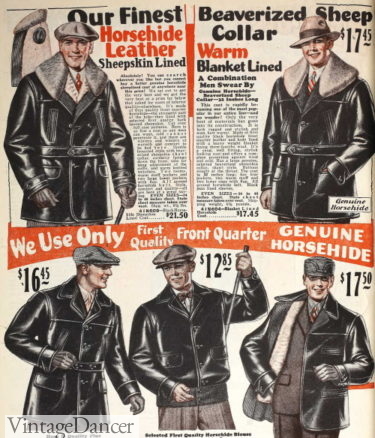
1928 leather short coats
1920s Men’s Jackets
Jackets, called windbreakers or lumberjacks, were the solution to a bulky but practical overcoat in mild weather. Borrowed from the working classes the jacket now looked like what we think of as a bomber jacket today, with knit ribbing around the waist and cuffs and, two button patch pockets at mid chest or lower and a fold out collar. This kept the wind, rain and snow out.
Heavy lumberjackets were made of thick Mackinaw cloth or heavy flannel cloth in bold plaid patterns. Leather lumberjacks were also worn.
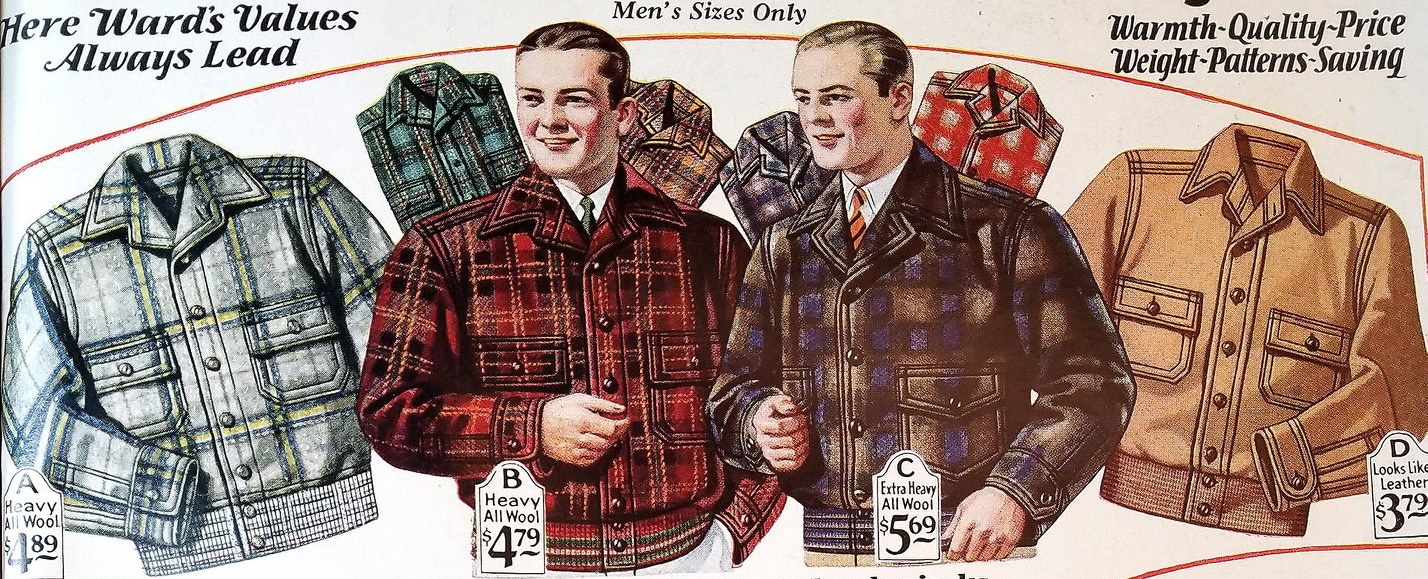
Late 1920s lumberjack jackets- heavy wool flannel or leather
Lighter versions of these jackets became trendy with the youth. Made of softer wool flannel, buckskin cloth or corduroy, the jackets still came in large plaids or thin leather with silk or satin lining. A knitted lumberjack shirt was another option for a cross between sweater and jacket.
- 1926 wool or corduroy lumberjacks
- 1928 wool flannel lumberjacks
- 1927 lumberjack flannel jackets
- 1928 Mackinaw cloth lumberjack
- Buckskin cloth lumberjack jacket and shirt
A knit collared version usually called a windbreaker was similar to the lumberjack. It was a working class jacket for the outdoor sportsman. See more 1920s men’s workwear coats and jackets.
- 1927 knit collar windbreakers
- 1928 unique windbreakers
1920s Style Men’s Coats
These new overcoats and jackets feature the overall style of men’s outerwear in the 1920s while some are reproductions. They make ideal layers for a 1920s look.
Debbie Sessions has been teaching fashion history and helping people dress for vintage themed events since 2009. She has turned a hobby into VintageDancer.com with hundreds of well researched articles and hand picked links to vintage inspired clothing online. She aims to make dressing accurately (or not) an affordable option for all. Oh, and she dances too.
